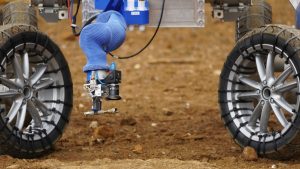The rover is pictured, navigating the terrain of a quarry on its own and retrieving an object. The sample tubes, explains ESA, are a replica of the hermetically sealed samples (thought to resemble ‘lightsabres’) that NASA’s Perseverance rover is leaving on Mars with Martian soil inside.
For the Mars Sample Return mission, a Sample Retrieval Lander will land (near or in Jezero Crater) bringing a small rocket on which these previously collected samples would be loaded. (Two Ingenuity-like helicopters could also provide a secondary capability to retrieve the samples on the surface of Mars.)
Stevenage
It’s the second time engineers from ESA and Airbus have come together in Stevenage, where Airbus Defence and Space is based, to conduct a field trial. Following some upgrades the rover was deemed complete enough to autonomously navigate unknown terrain, detect, and collect samples.
It features a robotic arm – shown in blue – which faced the challenge of picking up the thin, 15-cm long sample tubes dropped around a simulated depot.
“We are running these tests to bring together all the technologies we have developed individually,” says Pantelis Poulakis, project manager of ESA’s Sample Transfer Arm for the Mars Sample Return campaign. “This is essential to gain confidence in demanding scientific and exploration missions on Mars.”
Mapping
The rover mapped the terrain and located the tube, autonomously navigated towards it until it reached a parking position. It used stereo cameras to build up a 180-degree map of the surroundings and plan its next manoeuvres.
Once parked, the camera on top of the mast detected the tube and estimated its position with respect to the rover. The robotic arm initiated the complex choreography to move closer to the sample, fetch it and store it.
In full, the tests lasted two weeks and involved the rover traveling 300 metres across several obstacles – from flat and straight-line traverses to rocky, zig-zagging setups.
The engineers wanted the rover to learn how to scout another planet, dodging boulders and getting close to interesting samples, ESA explained. The rover, and its new arm, completed their work autonomously.
“Each new field trial is an opportunity to boost the European capability to run large scale tests for complex rover systems,” says Geoffray Doignon, Airbus Stevenage technical lead for rover breadboarding activities. “It helps us understand the limitations of the design and validate rover operations in realistic conditions.”
More work is still needed, however, with teams from industry and the ESA planning to further improve the wheeled robot’s performance next year.
See also: ESA opens new UK events venue on Harwell Science and Innovation Campus

